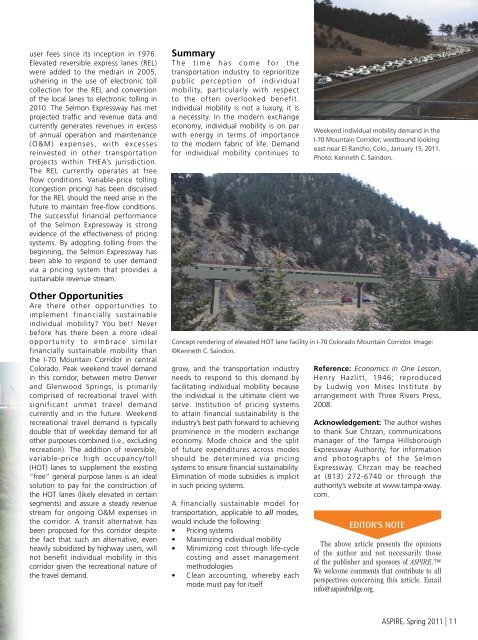ASPIRE Spring 11 - Aspire - The Concrete Bridge Magazine
ASPIRE Spring 11 - Aspire - The Concrete Bridge Magazine
ASPIRE Spring 11 - Aspire - The Concrete Bridge Magazine
You also want an ePaper? Increase the reach of your titles
YUMPU automatically turns print PDFs into web optimized ePapers that Google loves.
user fees since its inception in 1976.Elevated reversible express lanes (REL)were added to the median in 2005,ushering in the use of electronic tollcollection for the REL and conversionof the local lanes to electronic tolling in2010. <strong>The</strong> Selmon Expressway has metprojected traffic and revenue data andcurrently generates revenues in excessof annual operation and maintenance(O&M) expenses, with excessesreinvested in other transportationprojects within THEA’s jurisdiction.<strong>The</strong> REL currently operates at freeflow conditions. Variable-price tolling(congestion pricing) has been discussedfor the REL should the need arise in thefuture to maintain free-flow conditions.<strong>The</strong> successful financial performanceof the Selmon Expressway is strongevidence of the effectiveness of pricingsystems. By adopting tolling from thebeginning, the Selmon Expressway hasbeen able to respond to user demandvia a pricing system that provides asustainable revenue stream.Summary<strong>The</strong> time has come for thetransportation industry to reprioritizepublic perception of individualmobility, particularly with respectto the often overlooked benefit.Individual mobility is not a luxury, it isa necessity. In the modern exchangeeconomy, individual mobility is on parwith energy in terms of importanceto the modern fabric of life. Demandfor individual mobility continues toWeekend individual mobility demand in theI-70 Mountain Corridor; westbound lookingeast near El Rancho, Colo., January 15, 20<strong>11</strong>.Photo: Kenneth C. Saindon.Other OpportunitiesAre there other opportunities toimplement financially sustainableindividual mobility? You bet! Neverbefore has there been a more idealopportunity to embrace similarfinancially sustainable mobility thanthe I-70 Mountain Corridor in centralColorado. Peak weekend travel demandin this corridor, between metro Denverand Glenwood <strong>Spring</strong>s, is primarilycomprised of recreational travel withsignificant unmet travel demandcurrently and in the future. Weekendrecreational travel demand is typicallydouble that of weekday demand for allother purposes combined (i.e., excludingrecreation). <strong>The</strong> addition of reversible,variable-price high occupancy/toll(HOT) lanes to supplement the existing“free” general purpose lanes is an idealsolution to pay for the construction ofthe HOT lanes (likely elevated in certainsegments) and assure a steady revenuestream for ongoing O&M expenses inthe corridor. A transit alternative hasbeen proposed for this corridor despitethe fact that such an alternative, evenheavily subsidized by highway users, willnot benefit individual mobility in thiscorridor given the recreational nature ofthe travel demand.Concept rendering of elevated HOT lane facility in I-70 Colorado Mountain Corridor. Image:©Kenneth C. Saindon.grow, and the transportation industryneeds to respond to this demand byfacilitating individual mobility becausethe individual is the ultimate client weserve. Institution of pricing systemsto attain financial sustainability is theindustry’s best path forward to achievingprominence in the modern exchangeeconomy. Mode choice and the splitof future expenditures across modesshould be determined via pricingsystems to ensure financial sustainability.Elimination of mode subsidies is implicitin such pricing systems.A financially sustainable model fortransportation, applicable to all modes,would include the following:• Pricing systems• Maximizing individual mobility• Minimizing cost through life-cyclecosting and asset managementmethodologies• Clean accounting, whereby eachmode must pay for itselfReference: Economics in One Lesson,Henry Hazlitt, 1946; reproducedby Ludwig von Mises Institute byarrangement with Three Rivers Press,2008.Acknowledgement: <strong>The</strong> author wishesto thank Sue Chrzan, communicationsmanager of the Tampa HillsboroughExpressway Authority, for informationand photographs of the SelmonExpressway. Chrzan may be reachedat (813) 272-6740 or through theauthority’s website at www.tampa-xway.com.Editor’s Note<strong>The</strong> above article presents the opinionsof the author and not necessarily thoseof the publisher and sponsors of <strong>ASPIRE</strong>.We welcome comments that contribute to allperspectives concerning this article. Emailinfo@aspirebridge.org.<strong>ASPIRE</strong>, <strong>Spring</strong> 20<strong>11</strong> | <strong>11</strong>
















